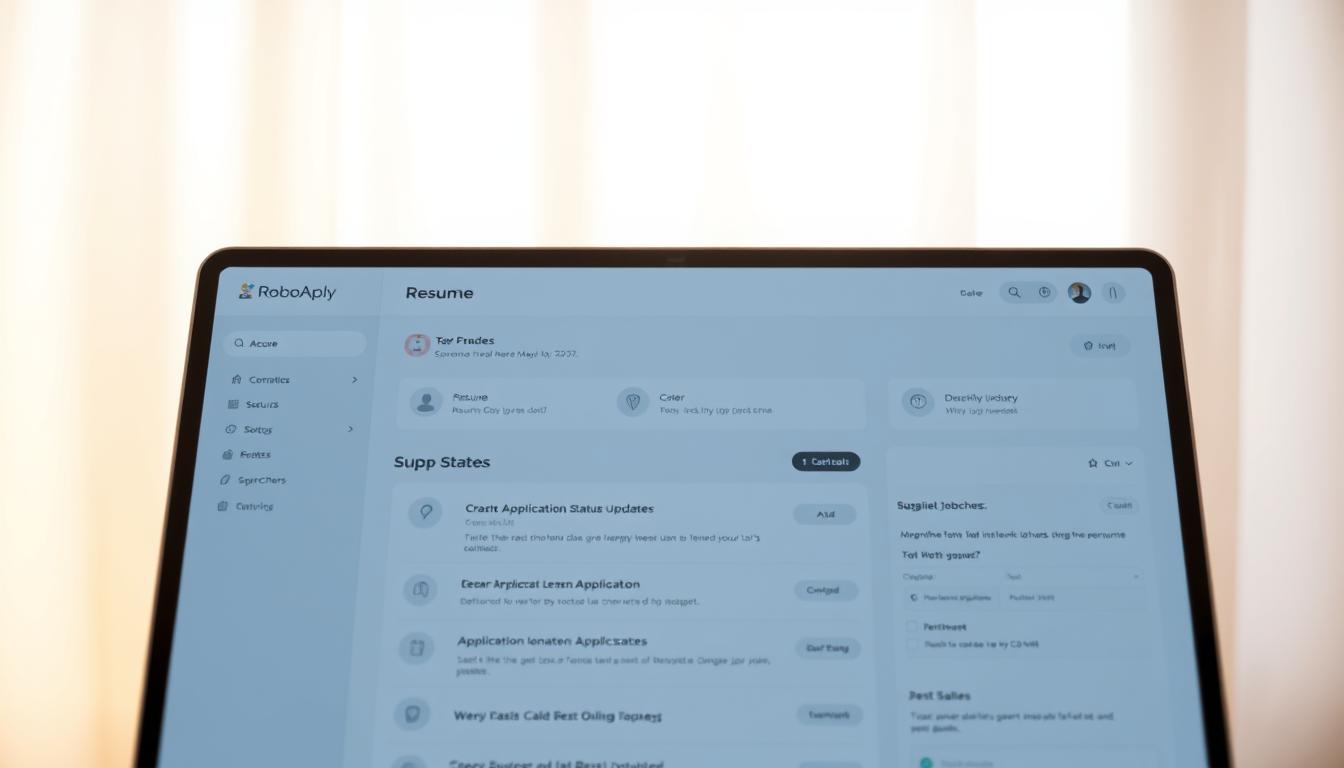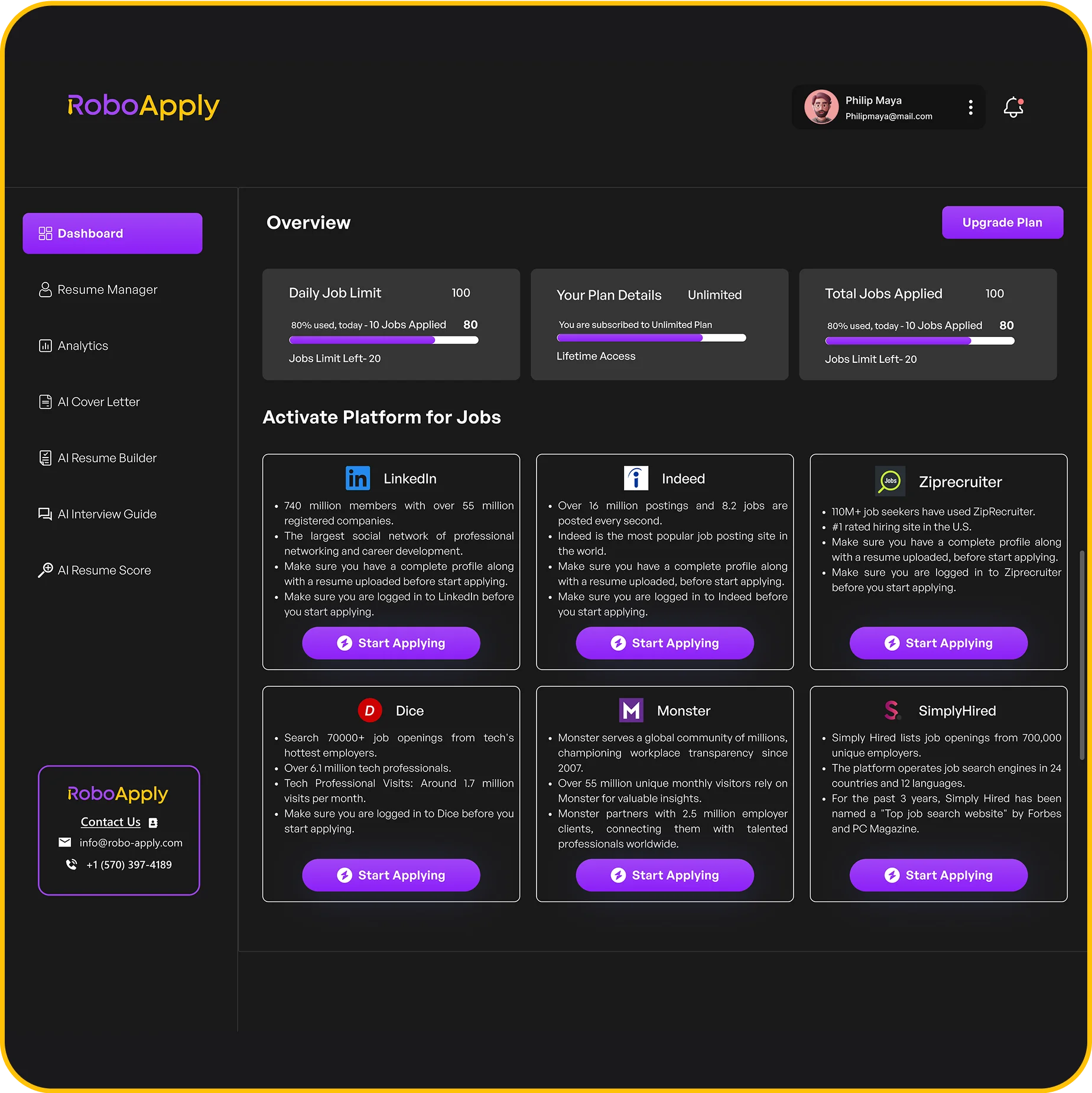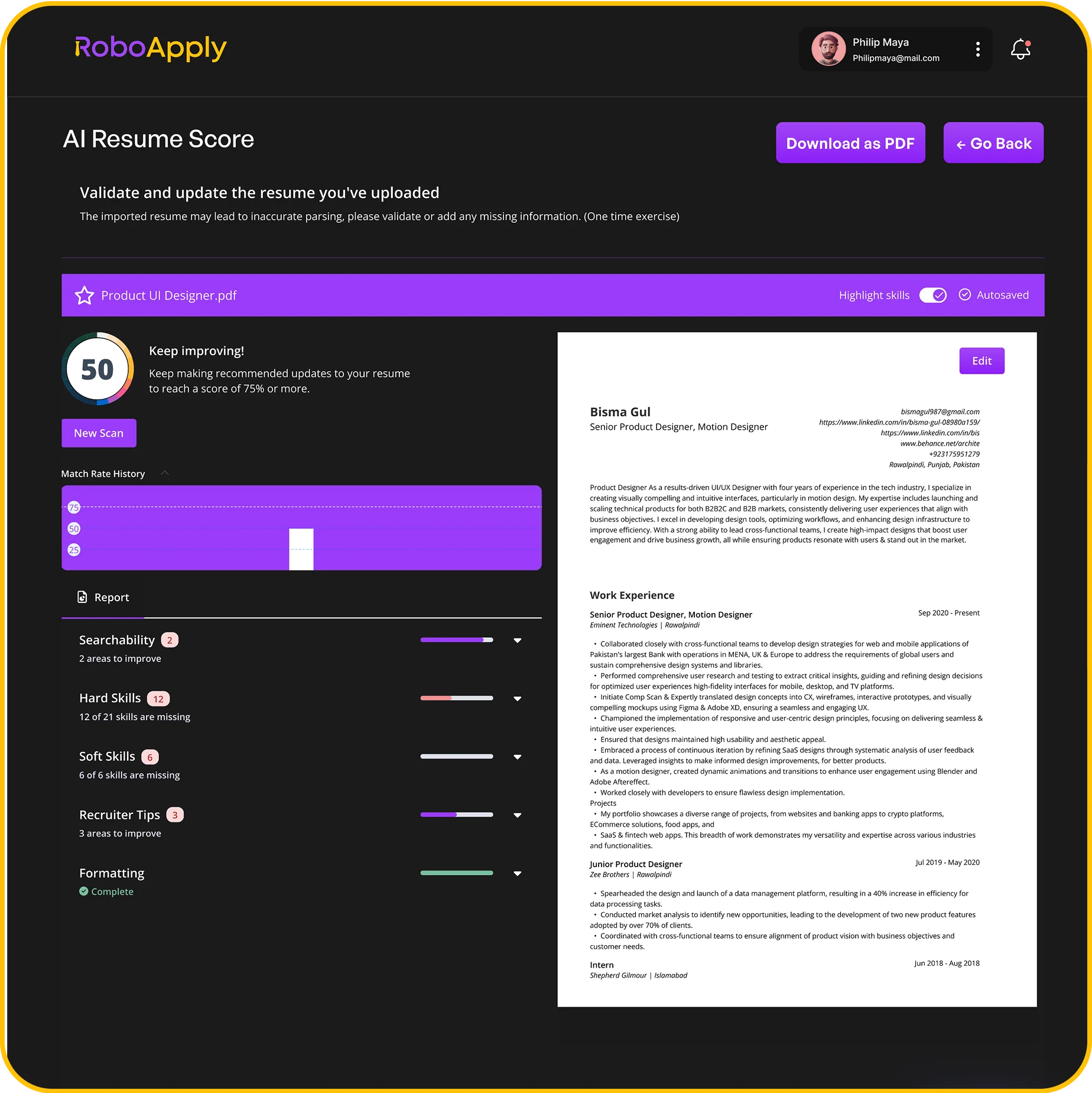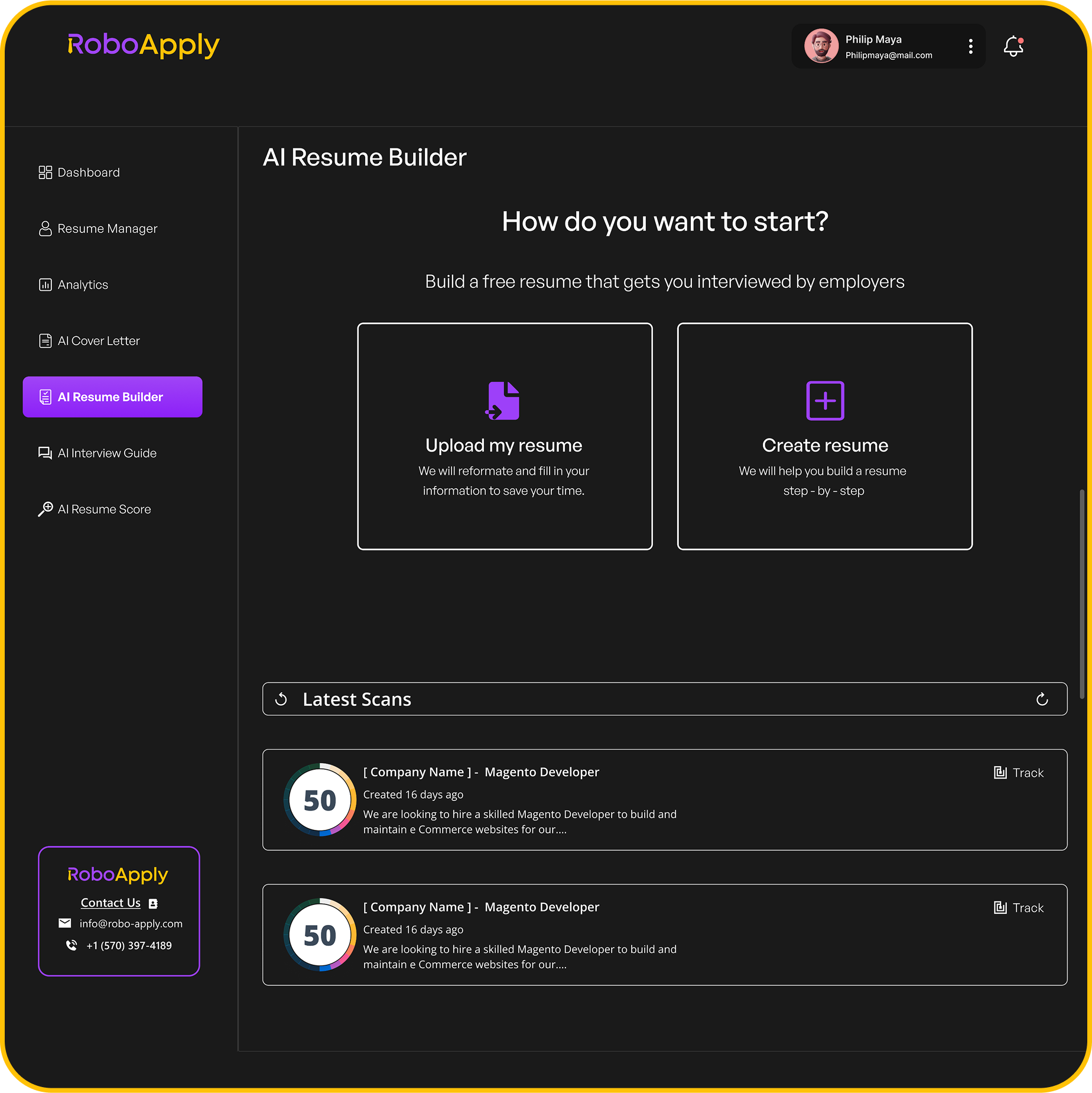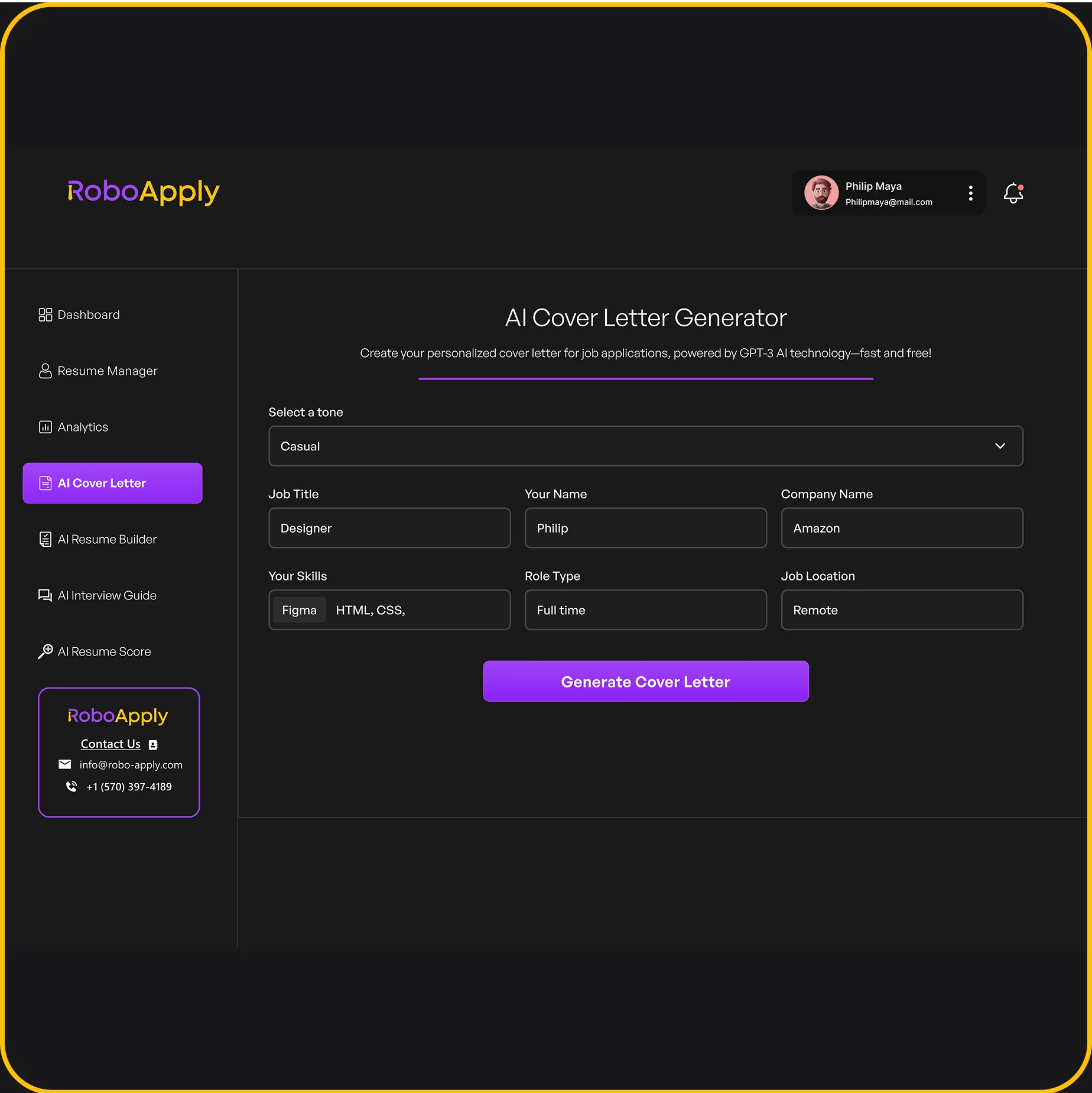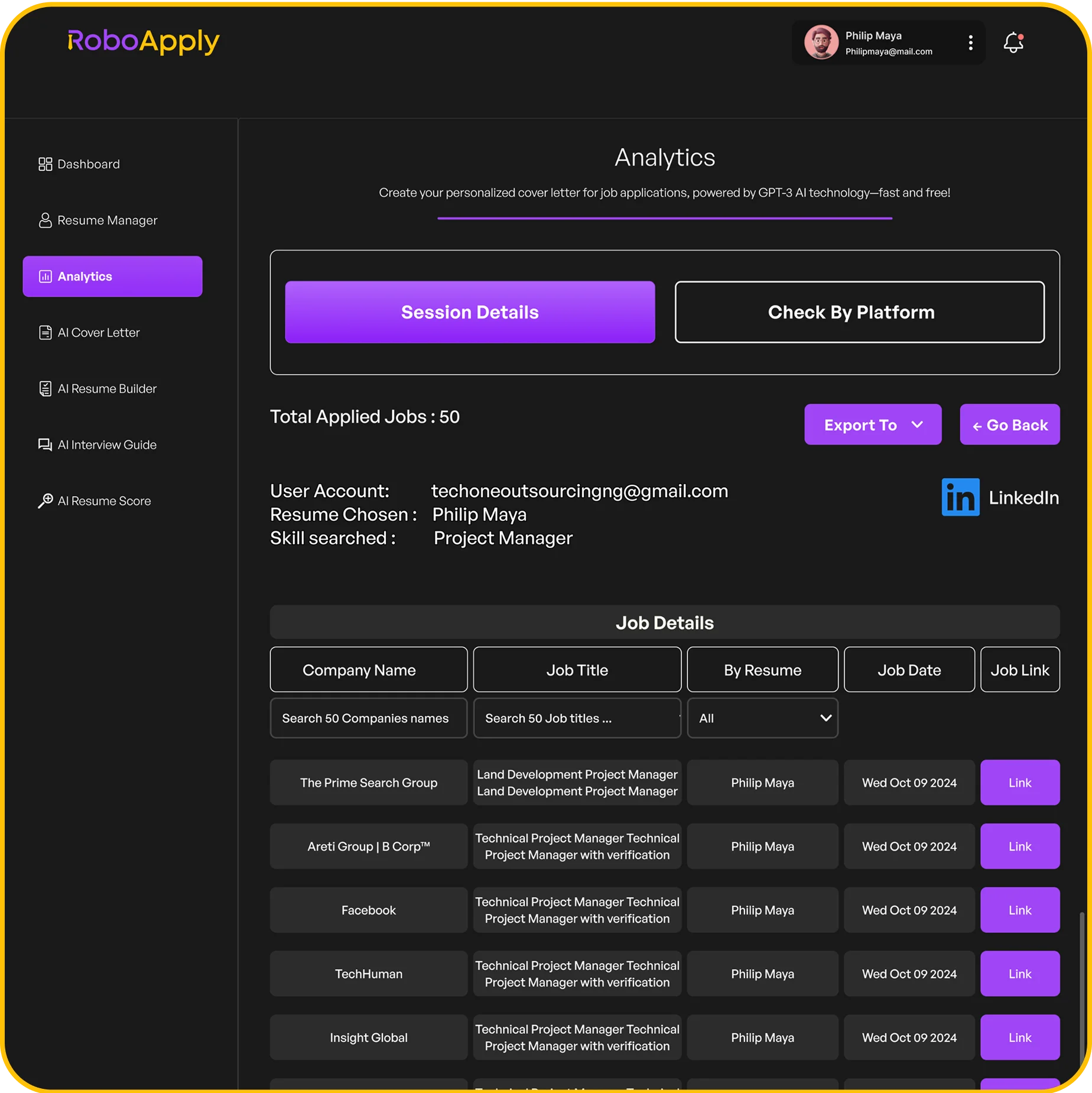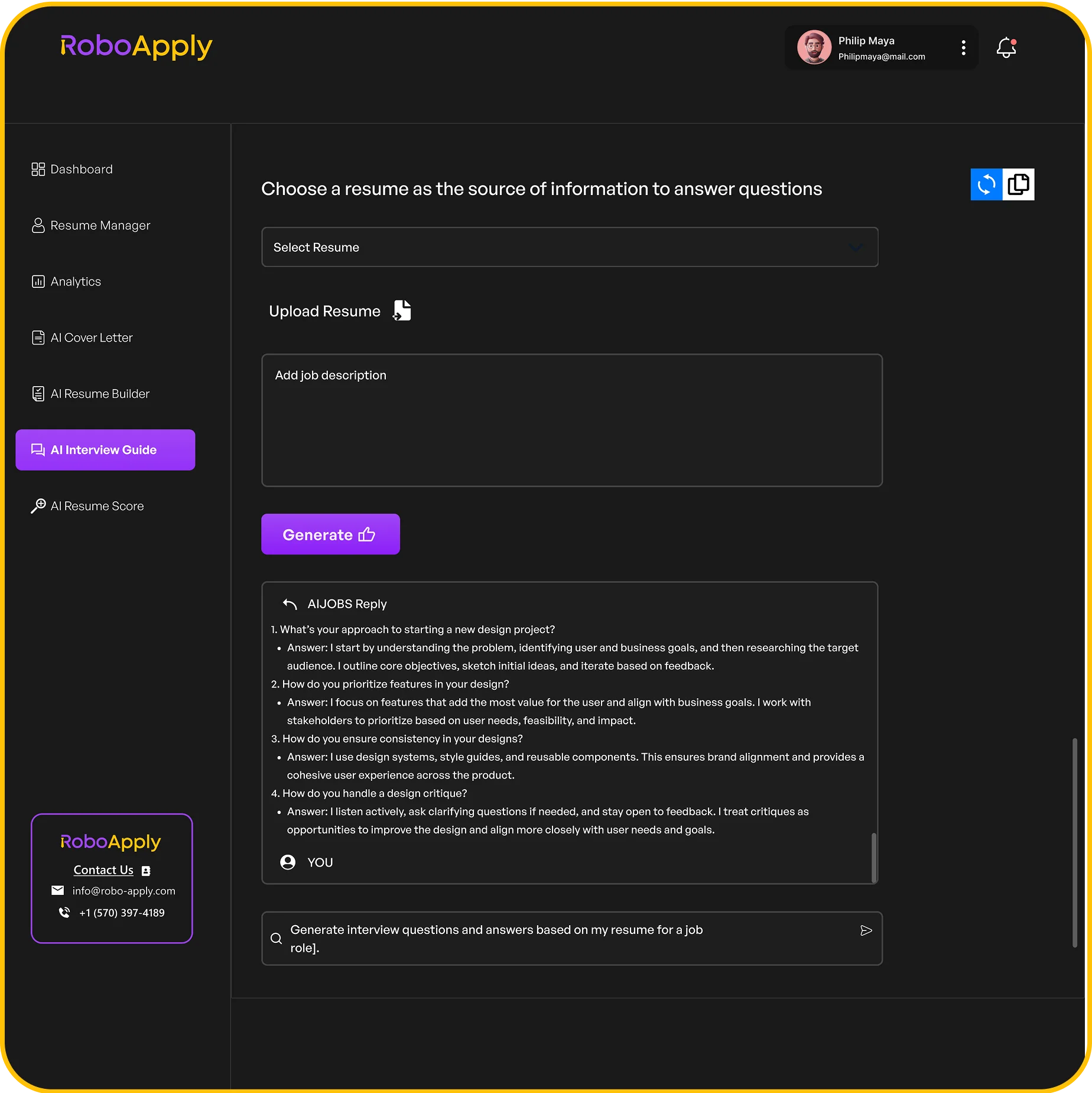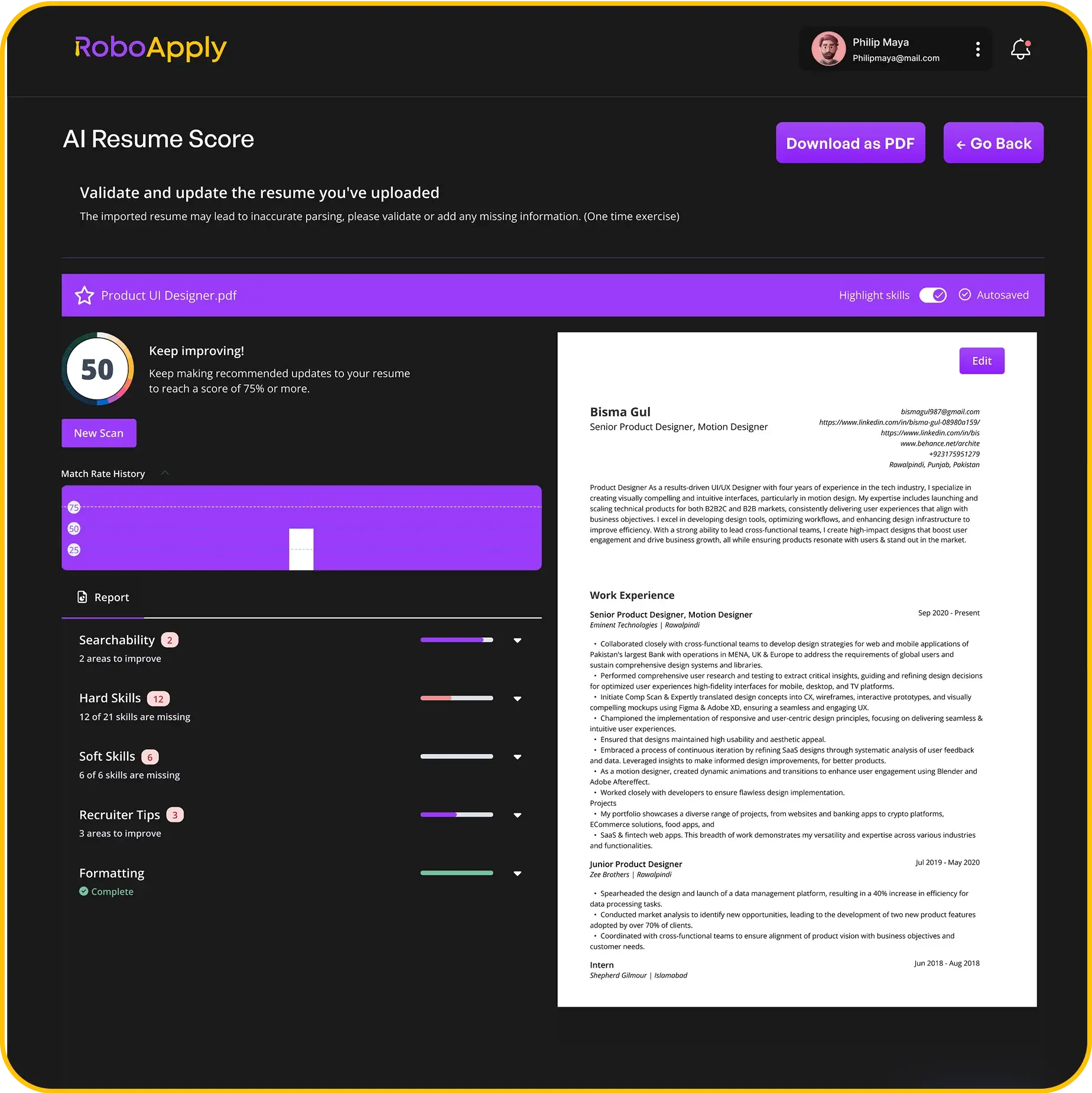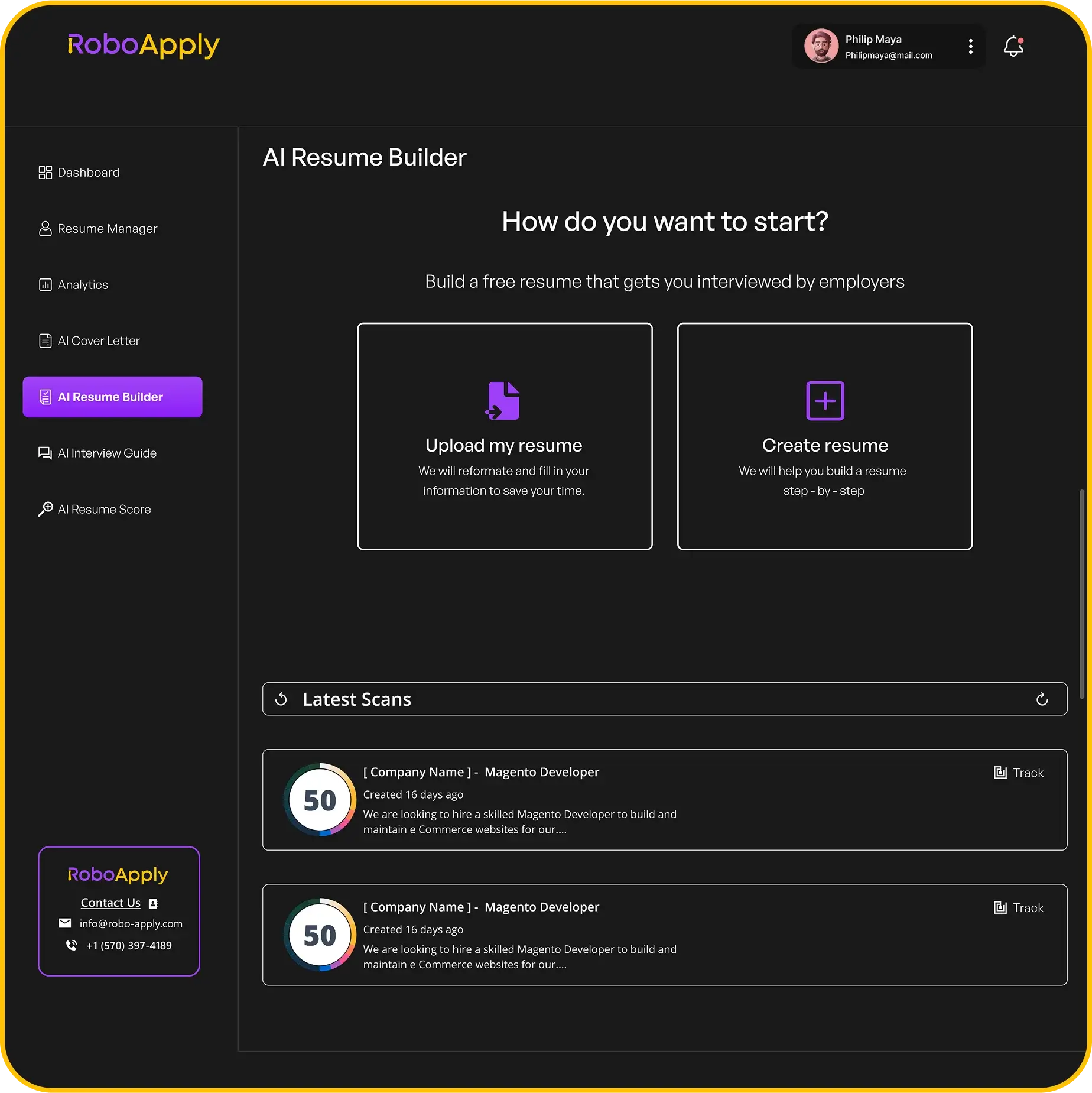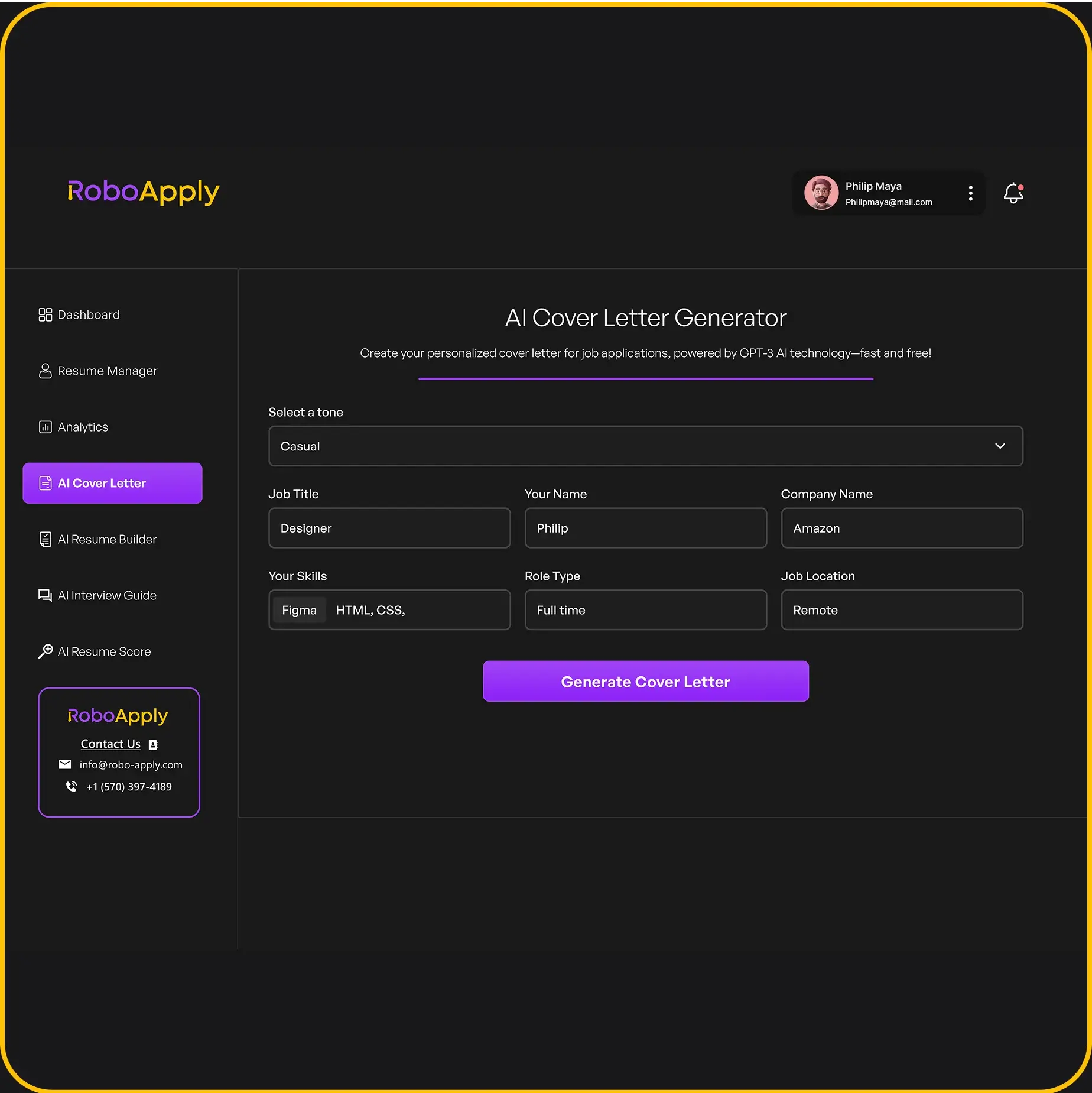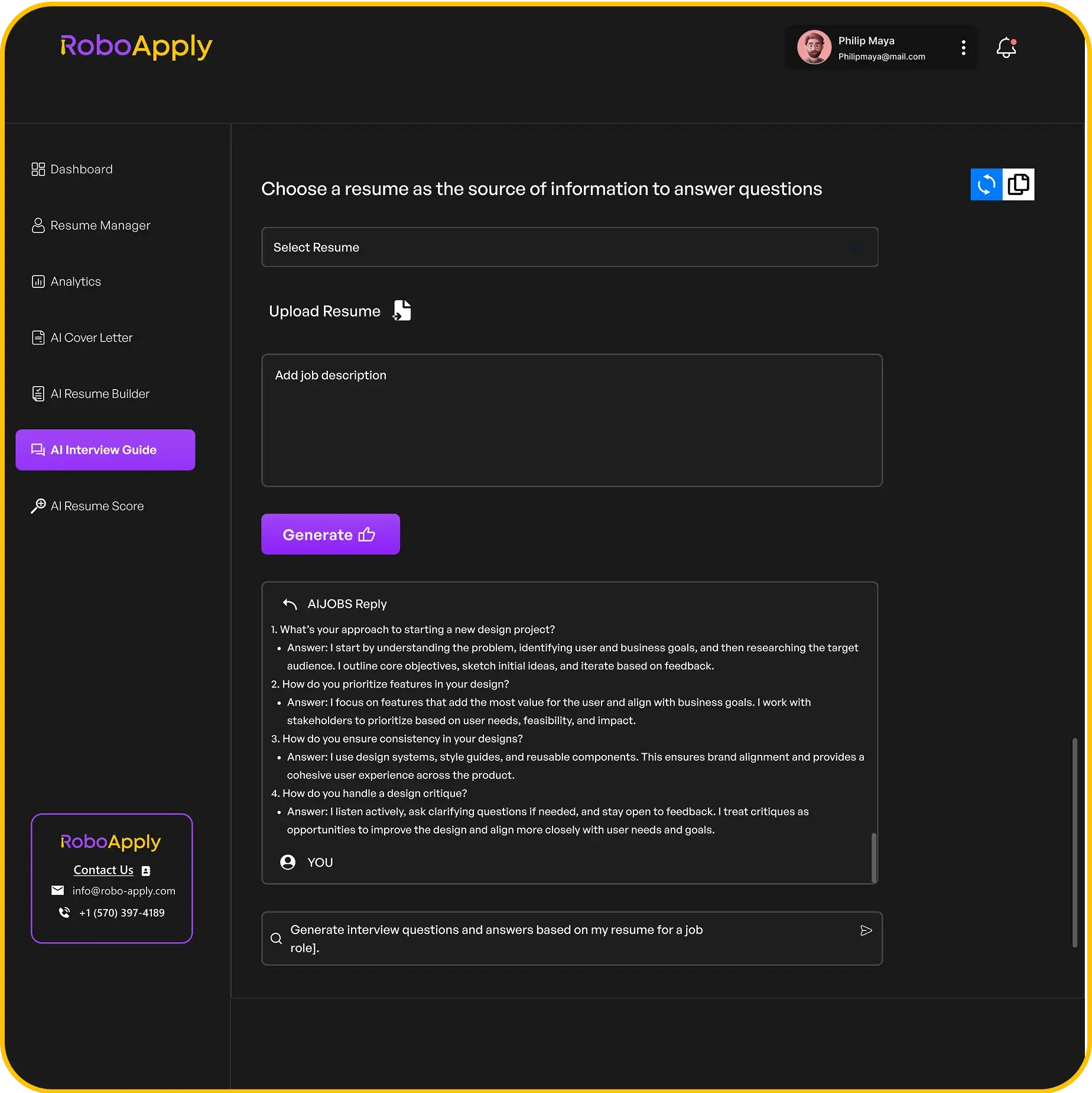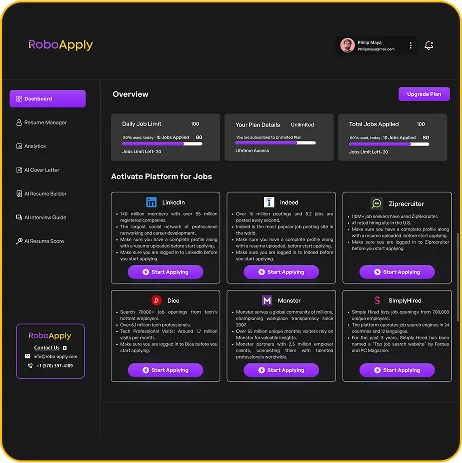Did you know that 83% of hiring managers read every single application document? Yet, only 26% of job seekers submit personalized cover letters. This gap is a huge chance for smart candidates.
Your resume shows your skills, but your application letter tells your story. It connects your experience with what the employer needs. The right approach can turn a simple application into a chance for an interview.
That’s where RoboApply comes in. Our AI platform makes creating compelling, personalized applications easy. You’ll learn strategies that help you stand out from the crowd.
These tips will change how you apply for jobs. Each method is based on proven job search strategies that work. Are you ready to improve your application success?
Key Takeaways
- Personalized applications get 83% more attention from hiring managers than generic ones
- Strategic storytelling in applications can increase interview callbacks by up to 40%
- AI tools like RoboApply can make application time shorter while improving quality
- Proper formatting and length (250-400 words) greatly impact reader interest
- Tailoring each application to specific job requirements shows you’re really interested
- Using professional yet easy-to-read language connects better with hiring managers
Understanding the Purpose of a Cover Letter
A cover letter is more than just a formality in your job search. It’s your chance to shine and stand out. Many see it as just a piece of paper, but it’s your personal marketing tool. It introduces you and highlights your professional background, showing why you’re a great fit for the job.
Your cover letter bridges the gap between your resume and your personality. It explains career changes, gaps, or special skills that your resume might not show. It shows your communication skills and interest in the job.
Why It Matters in Your Job Search
Cover letters are key in your effective job search strategy. They let you talk directly to the hiring manager and explain why you want to work for their company. This personal touch makes you different from others who send generic applications.
Hiring managers look at your cover letter to see how well you write and pay attention to details. These skills are important in most jobs. A good cover letter can make up for experience gaps or show skills that aren’t obvious from your resume.
Your cover letter shows you’re eager for the job. Companies want people who are excited about the role, not just looking for any job. A well-thought-out cover letter shows you’re serious and willing to put in the effort.
Key Elements of an Effective Cover Letter
A good cover letter has key parts that tell a story about why you’re the right fit. These parts include a personalized greeting, a strong opening, relevant skills, and a professional closing. Knowing these parts helps you write cover letters that really work.
The best cover letters connect your background to what the employer needs. They show how your experiences and achievements make you perfect for the job. RoboApply’s AI resume and cover letter builder helps you include all important parts and keep your document looking professional.
| Effective Cover Letter Elements | Purpose | Common Mistakes |
|---|---|---|
| Personalized Greeting | Shows research and attention to detail | Using “To Whom It May Concern” |
| Compelling Opening | Captures attention immediately | Starting with “I am writing to apply” |
| Relevant Skills Focus | Demonstrates job fit | Listing irrelevant experiences |
| Professional Closing | Encourages follow-up action | Ending abruptly without call-to-action |
These job search tips for cover letter structure work for everyone, no matter your experience. The trick is to tailor each part to fit the job and company. When you know what hiring managers want, you can write cover letters that get you interviews.
Your cover letter and resume work together to show your qualifications. Your resume gives the facts, and your cover letter adds the personal touch. This helps hiring managers see you in the role.
Tailoring Your Cover Letter for Each Job
Getting an interview often depends on how well you personalize your cover letter. Customizing your cover letter for each position shows you’ve done your homework. It sets you apart from those who send out generic applications.
About 75% of your cover letter should be redone for each application. It might take a lot of effort, but it’s worth it. Personalized cover letters show you’re really interested and can make you stand out.

Researching the Company
Doing your homework on the company is key to a successful job search. Start by checking their website, focusing on their mission, recent news, and culture. Understanding their values and goals helps you tailor your message.
Use Glassdoor to learn about company culture and interview processes. LinkedIn can give you insights into current employees and company updates. Look for information about their ideal candidate and recent achievements.
Notice the language they use in job postings and company communications. This will help you position yourself and highlight the right parts of your background.
Aligning Skills with Job Requirements
After researching the company, match your skills and experiences with their job requirements. Make clear connections between what you offer and what they need. This is key for a successful job hunt.
Review the job description and identify the top three to five requirements. For each, think of a specific example from your background that shows you have that skill or experience. Learning how to tailor your cover systematically ensures you meet their most important needs.
Don’t just list your qualifications. Explain how your background prepares you for their role. Show them you understand their challenges and can help them succeed.
Using Keywords from the Job Description
Using relevant keywords in your cover letter helps it pass ATS and shows you’re a good fit. Identify key terms and phrases from the job posting that relate to skills, qualifications, and responsibilities.
RoboApply’s ATS optimizer ensures your cover letters include the right keywords naturally. It analyzes job descriptions and suggests relevant terms to include in your application materials.
Use keywords naturally throughout your cover letter. Avoid stuffing them in, which can make your writing sound robotic. Instead, incorporate them into meaningful sentences that show your qualifications and enthusiasm for the position.
Crafting an Engaging Opening Paragraph
The first few lines of your cover letter are crucial. They decide if hiring managers keep reading or move on. Your opening paragraph is like a professional elevator pitch, packed into a few sentences. It must show your value and interest in the job right away.
Job search techniques show that hiring managers glance over each cover letter quickly. Your opening must stand out more than any other part. It should answer three key questions: who you are, why you’re interested, and what unique value you bring.
The Importance of a Strong Hook
A strong hook makes your cover letter stand out. It should grab attention and show your credibility. Think of it as your professional headline that makes hiring managers want to learn more about you.
Your hook should connect directly to the job requirements. Instead of saying you’re “hardworking” or “dedicated,” focus on specific achievements or experiences that align with the position. This shows you understand the role and have the right qualifications.
When learning how to start a cover letter, remember personalization is key. Address the hiring manager by name whenever possible. Research the company’s recent achievements, challenges, or initiatives to create a meaningful connection in your opening lines.
Effective hooks often include quantifiable achievements, relevant certifications, or unique experiences that set you apart. They should feel conversational yet professional, showing your personality while maintaining appropriate business tone.
Examples of Effective Introductions
Learning how to find a job successfully requires mastering various opening strategies. Here are proven examples that demonstrate different approaches to engaging introductions:
| Opening Type | Example | Why It Works | Best For |
|---|---|---|---|
| Achievement-Based | “After increasing social media engagement by 300% at my current company, I’m excited to bring my digital marketing expertise to ABC Company’s growing team.” | Quantifiable results immediately demonstrate value | Roles requiring measurable outcomes |
| Connection-Based | “Your recent expansion into sustainable packaging aligns perfectly with my five years of experience in eco-friendly product development.” | Shows company research and relevant experience | Companies with specific initiatives or values |
| Problem-Solution | “Having helped three startups streamline their operations and reduce costs by 25%, I understand the challenges facing growing companies like yours.” | Positions you as a solution to their needs | Consulting or problem-solving roles |
| Passion-Driven | “My passion for educational technology and proven track record of implementing successful learning platforms make me an ideal fit for your EdTech Developer position.” | Combines genuine interest with relevant skills | Mission-driven organizations or creative roles |
Achievement-Based Opening Example:
“Dear Ms. Johnson, As a marketing professional who increased lead generation by 150% through innovative digital campaigns, I’m thrilled to apply for the Digital Marketing Manager position at TechForward Solutions. Your company’s commitment to cutting-edge technology solutions resonates with my experience in developing data-driven marketing strategies that deliver measurable results. My background in both B2B and B2C marketing, combined with my expertise in marketing automation platforms, positions me to contribute immediately to your team’s continued success.”
Connection-Based Opening Example:
“Dear Mr. Rodriguez, Your recent Forbes article about sustainable business practices caught my attention, particularlly your emphasis on environmental responsibility in manufacturing. As a supply chain manager with seven years of experience implementing green logistics solutions, I’m excited to apply for the Operations Manager role at GreenTech Industries. My track record of reducing carbon footprints by 40% while maintaining cost efficiency aligns perfectly with your company’s mission and growth objectives.”
These job search techniques work because they immediately establish relevance and demonstrate that you’ve done your homework. Each example shows specific knowledge about the company or role while highlighting quantifiable achievements that matter to employers.
Remember that your opening paragraph sets the tone for everything that follows. Avoid starting with your name or using clichéd phrases like “I am writing to apply for…” Instead, jump directly into what makes you the right candidate for this specific position.
The most effective openings create curiosity while providing concrete evidence of your capabilities. They should make hiring managers think, “I need to learn more about this candidate.” This approach significantly increases the likelihood that they’ll read your complete application and consider you for an interview.
Highlighting Relevant Skills and Experiences
Employers want to see proof of your skills and experiences, not just hear about them. Your cover letter should show specific examples that prove your impact. This makes your application stand out as a real solution to their needs.
To succeed in your job search, pick achievements that match the job you want. Focus on skills mentioned in the job description. This way, hiring managers can quickly see how you can help their team.

How to Showcase Your Achievements
Look back at your last three to five years of work. Find moments when you solved big problems, improved processes, or went above and beyond. These moments are the foundation of your achievement stories.
Use the Challenge-Action-Result format for each achievement. Start with the problem or challenge. Then, describe the steps you took to solve it. End with the results you got.
For example, instead of saying “Managed a team well,” say “Led a team of 8 to make customer onboarding 40% faster and satisfaction 25% higher.” This shows your leadership and problem-solving skills clearly.
Share achievements from different parts of your career. Mention cost savings, revenue growth, efficiency boosts, team leadership, customer happiness, and process improvements. This shows you’re versatile and adaptable.
Using Metrics to Demonstrate Impact
Numbers make your achievements believable and memorable. They help employers see how big your contributions were. Every industry has metrics that matter, so find the right ones for your field.
Common metrics include percentages, dollar amounts, time saved, volume increases, and fewer errors. For sales, talk about revenue growth, meeting quotas, and new clients. In operations, highlight efficiency, cost cuts, and quality boosts.
If exact numbers aren’t available, use estimates or ranges. Use phrases like “approximately,” “nearly,” or “more than” to show impact without exaggerating. Aim for accuracy while showing meaningful contributions.
Here are ways to present different achievements:
- Revenue Impact: “Increased quarterly sales by $150,000 through strategic client relationship management”
- Cost Savings: “Reduced operational expenses by 15% while maintaining service quality standards”
- Efficiency Gains: “Automated reporting processes, saving 10 hours per week of manual work”
- Team Leadership: “Mentored 5 junior staff members, with 4 receiving promotions within 18 months”
Remember, your achievements should be real and something you can talk about confidently in an interview. Professional cover letter templates can help organize your achievements in a way that showcases your best work.
Your achievements show the value you’ll bring to your next role. They turn your cover letter into a strong case for why you’re the right fit.
Writing with a Professional Tone
Finding the right balance in your cover letter is key for a successful job search. Your tone shows who you are and how you’ll fit in. You should sound competent yet still be yourself.
Avoid being too formal or too casual. Think of your cover letter as a respectful conversation with someone you respect but don’t know. Be yourself, but with good manners.
Balancing Formality and Personality
You can be professional without being stiff. Use everyday language that feels natural. Instead of saying “I am writing to express my interest,” say “I’m excited about the opportunity to join your team.” This sounds more human and still fits.
Show your excitement through your words. Use active verbs like “developed,” “created,” and “improved.” Be proud of your achievements. Say “I successfully led a team of five” instead of “A team of five was managed by me.”
Your personality can shine through specific details. Share what excites you about the role. Mention something specific about the company that caught your attention. This makes you stand out while staying professional.
- Use contractions naturally – “I’m” instead of “I am” sounds more conversational
- Choose simple words – “help” works better than “facilitate”
- Write like you speak – read your letter aloud to check the flow
- Show genuine interest – explain why this specific job appeals to you
Avoiding Common Tone Pitfalls
Many job seekers make the mistake of sounding too formal or too casual. Overly formal writing uses complex sentences and jargon that creates distance. Clear communication impresses more than fancy vocabulary.
Being too casual can also hurt your chances. Avoid slang, emoji, or overly familiar language. Don’t use casual greetings or phrases like “awesome opportunity.” Save the casual tone for after you get the job.
Another mistake is sounding desperate or overly eager. Phrases like “I’ll do anything” or “I need this job” make you appear less confident. Instead, focus on what you bring to the table and why you’re a good fit.
Generic language is also a problem. Avoid phrases that could apply to any job or company. Personalize your tone to match the company’s culture while staying professional. A tech startup might appreciate a slightly more relaxed tone than a law firm, but both expect professionalism.
Remember, your cover letter tone sets expectations for how you’ll communicate as an employee. Show that you can adapt your communication style while maintaining authenticity and professionalism.
Keeping It Concise and Focused
Your cover letter’s strength comes from being precise and focused. Hiring managers see many applications every day. So, every word you write is crucial for your success. By following job search best practices, you show respect for their time and deliver a strong message through brevity.
Good cover letters find a balance between giving enough information and being easy to read. You should highlight your skills without filling the page with too much.

Recommended Length for Cover Letters
The best cover letter is 250 to 400 words long. It should have three to four focused paragraphs. This length lets you show your qualifications without losing the reader’s interest.
Your first paragraph should catch the reader’s eye right away. The next paragraphs should talk about your experience and achievements. The last paragraph should show your interest and ask for a follow-up.
Letters that are too short might not have enough to say. Letters that are too long can bore the reader. Smart job seekers know that finding this middle ground shows they can communicate well and are aware of professional standards.
“The most valuable of all talents is that of never using two words when one will do.”
Tips for Editing and Revising
Begin by reading your cover letter out loud. This helps you spot awkward sentences and confusing phrases.
Get rid of words like “very,” “really,” and “quite” if they don’t add value. Use action-oriented language to show what you can do.
Use bullet points to list achievements or qualifications. This makes your letter easier to read and helps important information stand out.
Stick to one idea per paragraph. This makes your letter clear and easy to scan.
Follow job search best practices by proofreading many times. Take breaks to catch mistakes you might overlook.
Tools like RoboApply’s optimization features can help keep your word count right. They make sure your cover letters are effective and meet industry standards.
Incorporating a Personal Touch
Adding personal touches to your cover letter makes it stand out. It turns a generic application into a story that hiring managers can relate to. This way, you show your true self while still being professional.
It’s important to balance your personal stories with your professional skills. This helps you connect with hiring managers on a deeper level.
Job seekers know that hiring managers want to see the real person behind the resume. Your cover letter is the perfect place to show how you fit in with the company’s culture. This job hunting advice helps you build genuine connections.

Sharing Your Story
Your career journey is unique, filled with experiences that shaped you. Effective storytelling in cover letters shows how you’ve grown from challenges to skills. This helps employers see your motivation and growth mindset.
Start by picking key moments in your career that show your resilience, learning, or innovation. These stories should link directly to the job you’re applying for. For example, if you’re applying for a project management role, talk about a time you led a tough project and learned a lot about teamwork.
Keep your stories short and focused on the outcomes. Hiring managers like brief stories that show your problem-solving skills and growth. RoboApply’s job tracker helps you organize these stories with company research, making sure you pick the right ones for each application.
Your story should show how you’ve moved from where you’ve been to where you want to go. This shows you’ve planned your career and are ready for their challenges.
Making a Connection to the Company
Research shows that shared values and interests create real connections with employers. Cultural alignment is as important as technical skills in hiring. Your cover letter should show you understand the company’s culture and mission.
Look at the company’s website, social media, and recent news to find their core values and initiatives. Find ways to connect your personal values with theirs. This advice helps you show you’ll thrive in their environment.
Share specific examples of how your values match theirs. If they value community involvement, mention your volunteer work. If they focus on innovation, talk about your creative problem-solving experience. These connections feel natural with real examples.
| Company Value | Personal Connection | Cover Letter Example | Impact on Hiring Manager |
|---|---|---|---|
| Innovation | Led digital transformation project | “Your commitment to technological advancement aligns with my experience leading our department’s digital transformation” | Shows shared priorities and relevant experience |
| Community Focus | Volunteer mentoring experience | “Like your company’s mentorship programs, I’ve found fulfillment in guiding junior professionals” | Demonstrates cultural fit and giving mindset |
| Sustainability | Environmental advocacy background | “Your sustainability initiatives resonate with my personal commitment to environmental responsibility” | Shows authentic passion beyond job requirements |
| Collaboration | Cross-functional team leadership | “Your emphasis on teamwork mirrors my approach to building bridges between departments” | Indicates strong interpersonal skills |
RoboApply’s templates help you add personal touches while staying professional. The platform’s research tools help you find cultural connections that feel real without being forced.
Remember, being authentic is more important than being perfect when sharing personal elements. Hiring managers can tell if you’re genuinely passionate and aligned with their values. Focus on being honest and building real connections.
Closing Your Cover Letter Effectively
A strong conclusion turns your cover letter into a powerful call to action. It’s your last chance to show hiring managers you’re worth considering. You want to leave them eager to reach out and learn more about you.
The best closings mix respect with enthusiasm. You should show you’re genuinely interested in the job. Strong closings also help you stand out during interviews.
Your closing paragraph should do three things. First, show your excitement for the role and company. Second, highlight your key qualifications in a new way. Third, include a clear call to action to get the hiring manager to respond.
Restating Your Interest in the Position
Showing your interest means more than just saying you’re excited. You need to show you’ve done your homework on the company. Effective job search strategies include personalized closings that mention company goals or achievements.
Link your enthusiasm to reasons why this job fits your career goals. Talk about how the company’s values align with yours. For example, you might mention their innovative customer service or commitment to growth.
Avoid generic phrases like “I look forward to hearing from you.” Instead, create statements that show you understand the company’s needs. For example, “I’m excited to help your team grow in the Northeast region.”
Successful candidates often mention specific projects from the job description. This shows you’ve read the posting carefully and can contribute to those efforts. It also shows you’re interested in the job itself, not just any job.
Encouraging Follow-Up
Your call to action should be confident but not too pushy. Suggest specific next steps to make it easy for hiring managers to respond. Professional closings often include phrases like “I would welcome the chance to discuss how I can help your team.”
Offer different ways for employers to contact you. You might suggest a phone call, video chat, or meeting. This shows you’re flexible and serious about moving forward.
Include a timeline for follow-up to show you’re proactive. For example, “I’ll check in next week to make sure you got my application.” This shows initiative while respecting their time.
End with a formal closing that fits your industry. “Sincerely” is good for most professional settings, while “Best regards” is a bit more modern. Learning how to close a cover letter well means knowing these differences.
Remember to include your full name and contact info in your signature. Even if it’s in your header, repeating it makes it easy for hiring managers to get in touch. Some people also add their LinkedIn profile URL for more context.
The best closings create a sense of urgency without being too pushy. You want hiring managers to feel like they might miss out if they don’t act fast. This approach works well when you share specific examples of your achievements.
Common Cover Letter Mistakes to Avoid
Even the most qualified candidates can mess up their job search with common cover letter mistakes. These errors can quickly knock you out of the running, no matter how great your background or resume. Knowing and avoiding these common mistakes can greatly boost your chances of getting that important interview.
Hiring managers often only spend less than 30 seconds on each cover letter. In this short time, any mistake can leave a bad first impression. The good news is that most cover letter mistakes are avoidable with the right attention and tools.
“A single typo in a cover letter can cost you the job opportunity, as it signals carelessness and lack of attention to detail.”
Generic Language
Using generic language shows you’re not really interested in the job. Phrases like “I am writing to apply for the position” or “I would be a great fit for your company” don’t tell hiring managers anything about you.
Instead, customize every sentence to match the specific job and company. Use concrete examples that show you understand their needs. RoboApply’s customization features help you avoid generic language by prompting specific details for each application, making your cover letter stand out.
Avoid phrases that could apply to any job at any company. Your cover letter should be so specific that it couldn’t possibly be sent to another employer without major changes.
Typos and Grammatical Errors
Spelling mistakes and grammatical errors can destroy your professional image. These errors suggest you’re careless and lack attention to detail – qualities employers don’t want.
Common mistakes include misspelling the company name, using the wrong verb tenses, and confusing “their” and “there.” Even small mistakes can have big effects in competitive job markets.
RoboApply’s built-in grammar checker automatically identifies potential errors before you submit your application. This feature catches mistakes that spell-check might miss, including contextual errors and awkward phrasing that could weaken your message.
Always proofread your cover letter multiple times. Consider reading it aloud to catch errors your eyes might miss. These job search tips can make the difference between getting noticed and getting overlooked.
Ignoring Formatting Guidelines
Poor formatting can make even great content look unprofessional. Common mistakes include inconsistent fonts, improper spacing, and layouts that don’t display correctly across different devices.
Your cover letter should have consistent formatting, proper margins, readable fonts, and clear paragraph breaks. Avoid fancy fonts or colors that might not display properly in all email systems or applicant tracking systems.
RoboApply ensures your cover letter maintains professional formatting standards across all platforms, preventing display issues that could hurt your application. The platform’s formatting features guarantee your letter looks polished whether viewed on desktop, mobile, or printed.
Many companies use applicant tracking systems that can struggle with complex formatting. Keep your design clean and simple to ensure your content gets through these systems successfully. Following these essential job search tips will help you avoid the formatting pitfalls that eliminate countless qualified candidates.
Additional Resources for Crafting Cover Letters
Finding the right resources can make your cover letter writing easier. Professional tools and expert advice are key for effective job search success. They help you make applications that grab hiring managers’ attention.
Online Tools and Templates
RoboApply is a top platform for streamlining your application process. It uses AI to create custom content based on job descriptions. It also checks grammar and optimizes for ATS.
The auto-apply Chrome extension makes your workflow smoother. It lets you track applications and keep your submissions consistent. This saves time and boosts application quality.
Professional template libraries offer structured formats that match your resume. Choose templates that fit your industry and career level. Consistency between your resume and cover letter creates a cohesive professional image.
Useful Books and Guides
Industry-specific writing guides offer targeted job search guidance for your field. They share insider knowledge on what hiring managers look for. They include examples and case studies from successful job seekers.
Career development books go beyond cover letter basics. They cover networking, interview prep, and long-term planning. This comprehensive approach strengthens your overall job search strategy.
Professional development resources help you find tools that meet your needs. Look for guides that match your career level and industry. Updated editions reflect current trends and best practices.
| Resource Type | Key Benefits | Best For | Time Investment |
|---|---|---|---|
| AI-Powered Platforms | Automated customization, ATS optimization | High-volume applications | 15-30 minutes per letter |
| Professional Templates | Consistent formatting, visual appeal | Design-conscious industries | 10-20 minutes setup |
| Industry Guides | Specialized knowledge, insider tips | Specific career fields | 2-4 hours reading |
| Career Development Books | Comprehensive strategy, long-term planning | Career changers, new graduates | 5-10 hours reading |
These resources together form a strong support system for your applications. Combining digital tools with expert knowledge boosts your chances of getting interviews. Investing in quality resources pays off throughout your career.
Staying Positive and Persistent in Your Job Search
Your cover letter skills are just one part of finding a job. The journey ahead needs mental toughness and smart planning. Studies show 25% of Millennials will have six or more jobs in their careers. So, having good job search skills is key for success.
The Importance of a Growth Mindset
Rejection is normal, not a sign of your worth. Use the 3-to-1 rule: for every rejection, take three positive steps. This could mean improving your cover letter, making new contacts, or applying to more jobs. Staying positive gets easier when you see each application as a chance to learn.
Set achievable goals to track your progress. If you send 50 applications and 20 LinkedIn messages, expect 10 responses. This could lead to 4 interviews and maybe 1 job offer. These numbers show that success in job hunting comes from trying a lot and not giving up.
Celebrating Small Wins
Celebrate every small success. Finishing a great cover letter, getting an informational interview, or hearing positive feedback are all worth celebrating. These small wins keep you motivated and moving forward.
Take care of yourself during your job search. Set both short-term and long-term goals to stay focused. Helping others find jobs can also help you and improve your mood. Remember, job hunting is about balance – working hard and taking breaks.
FAQ
Why are cover letters still important in today’s job market?
Cover letters are still key because they add context to your resume. They show off your communication skills and interest in the job. With RoboApply’s AI, you can make cover letters that catch hiring managers’ eyes and boost your chances of getting an interview.
What are the essential components of an effective cover letter?
A good cover letter has personalized greetings, strong opening lines, and relevant skills. RoboApply’s AI helps you include these elements while keeping it professional. This helps you know what hiring managers want and how to structure your cover letter for impact.
How do I customize my cover letter for each job application?
Start by researching the company well. Understand their mission, culture, and recent achievements. Then, match your skills and experiences with the job’s needs. RoboApply’s ATS optimizer ensures your cover letters have the right keywords but still sound natural.
What makes an opening paragraph engaging and effective?
A great opening grabs attention by showing enthusiasm, relevant experience, and interest in the job. Avoid clichés and start with something unique. RoboApply’s AI suggests personalized opening lines based on the job and company, making your introductions stand out.
How can I effectively showcase my achievements in a cover letter?
Turn your work history into proof by highlighting your most relevant achievements. Use specific numbers and outcomes like cost savings or team successes. RoboApply’s grammar checker makes sure your descriptions are clear and professional, and templates help organize your achievements well.
How do I maintain the right tone in my cover letter?
Find the right balance between being professional and showing your personality. Avoid too formal or too casual language. RoboApply’s AI helps you keep the right tone and shows your personality, making you seem both competent and relatable.
What’s the ideal length for a cover letter?
Keep it short and impactful, usually one page or 250-400 words. Cut unnecessary words and make every sentence count. RoboApply’s tools help you stay within the ideal length while keeping your message clear.
How can I add a personal touch without being unprofessional?
Add personal touches by sharing brief, compelling stories that show your career growth and fit with the company. Research the company culture well and share relevant personal experiences. RoboApply’s job tracker and templates help you add personal touches the right way.
What should I include in my cover letter closing?
End with a strong impression by expressing continued interest and suggesting next steps. Restate your enthusiasm in fresh ways that highlight your qualifications. RoboApply’s templates include proven formulas that have helped many job seekers get interviews.
What are the most common cover letter mistakes to avoid?
Avoid generic language and ensure your writing is error-free. Follow formatting guidelines and make every sentence meaningful. RoboApply’s tools help you avoid common mistakes and keep your cover letter professional.
What tools and resources can help me write better cover letters?
RoboApply offers a full suite of tools, including an AI builder, grammar checker, and job tracker. It also has industry guides and career books to enhance your job search. These resources help you write better cover letters and maintain consistency in your applications.
How do I stay motivated during my job search process?
Stay motivated by seeing each application as a learning chance. Maintain a growth mindset and celebrate small wins. RoboApply’s tools help you prepare for interviews and track your progress, showing you how to improve.
How do I incorporate keywords from job descriptions effectively?
Use relevant keywords from job descriptions naturally in your cover letter. Focus on skills and terms that match your experience. RoboApply’s ATS optimizer ensures your cover letters pass ATS checks, increasing your visibility to hiring managers.
Should I mention salary expectations in my cover letter?
Generally, don’t mention salary expectations unless asked in the job posting. Focus on showing your value and qualifications. Save salary talks for later when you have more information about the role.
How can I make my cover letter stand out in competitive job markets?
Stand out by using specific metrics and outcomes to show your impact. Share compelling stories that show cultural fit and avoid generic language. RoboApply’s AI tools help you create unique content that differentiates you professionally.




